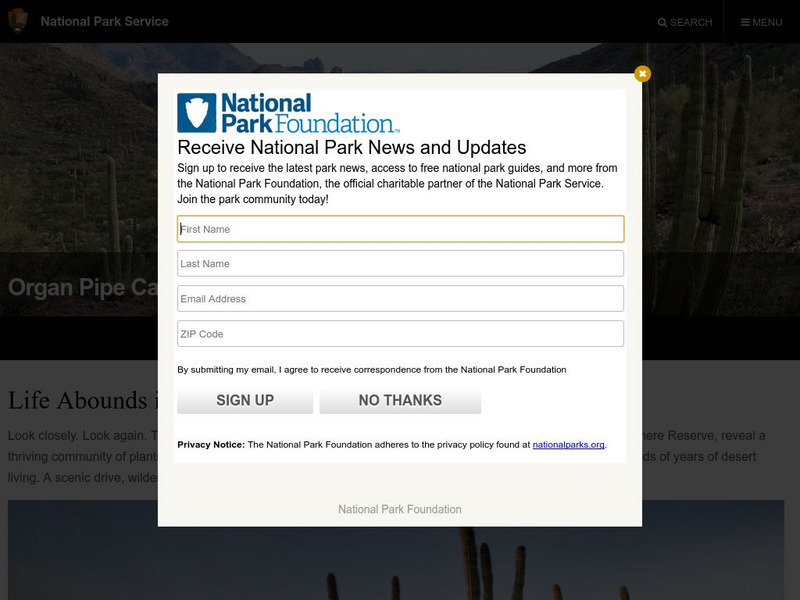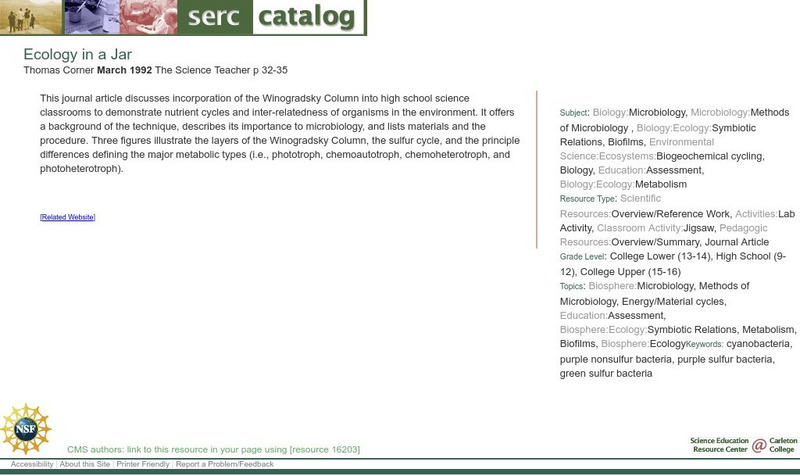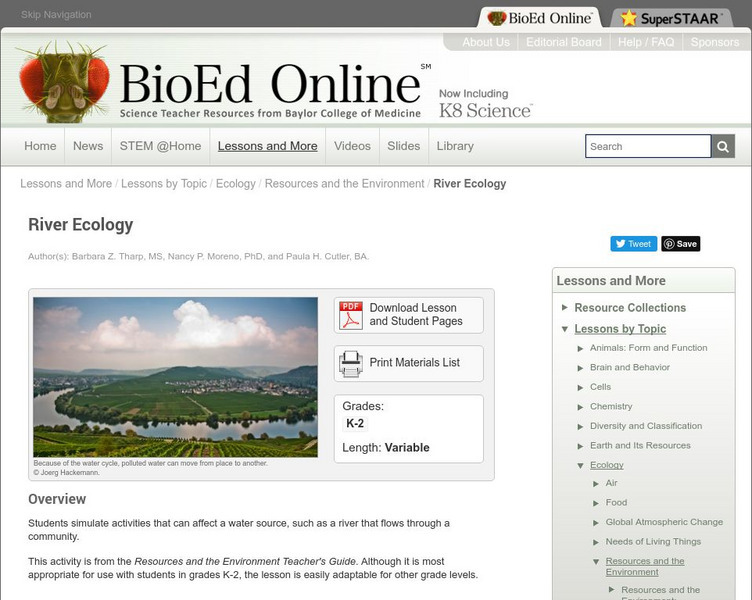Hi, what do you want to do?
Open Curriculum
Open Curriculum: Science of Ecology
This illustrated article helps students identify levels of organization in ecology.
CK-12 Foundation
Ck 12: Life Science: 12.1 Ecology Overview
Discover how organisms interact in their environment.
Science Struck
Science Struck: The 6 Chief Levels of Organization in Ecology
Describes six levels of organization in the biological world - individual species, population, community, ecosystem, biome, and biosphere.
BioMan Biology
Bio Man Biology: Ecology Quizzes
Three multiple-choice quizzes on topics and vocabulary in ecology.
Georgia Department of Education
Ga Virtual Learning: Biology: Ecology I
A comprehensive ecology learning module where students assess the dependence of all organisms on one another and the flow of energy and matter within their ecosystems.
Curated OER
National Park Service: Organ Pipe Cactus National Monument
Organ Pipe Cactus National Monument in the Sonoran Desert, in Arizona, was declared a national monument to preserve the ecological wonders it houses. Peruse the history, culture, nature and science. Teachers, be sure to check out the...
Other
Save Our Seas Organization: Home Page
Home page of the Save Our Seas Organization which seeks to protect all the oceans of the world.
Untamed Science
Untamed Science: Ecology: The Study of Interactions
Learn about how ecology is simply the study of how and why organisms interact with their environments.
Other
My Science Box: Ecosystem Organization
In this lesson, learners will learn about the different levels in the hierarchy of ecology and explain the relationships: organism, population, community, ecosystem, biome, and biosphere. They will also discover why different regions...
Science Education Resource Center at Carleton College
Serc: Ecology in a Jar
This journal article discusses incorporation of the Winogradsky Column into high school science classrooms to demonstrate nutrient cycles and inter-relatedness of organisms in the environment.
Other
The Dirty Dozen Persistent Organic Pollutants
Use this site to learn about the effects of persistent organic pollutants on the ecology of Antarctic coastal waters. Information is presented for both teacher and student researcher.
BioMan Biology
Bio Man Biology: Angry Aliens: Ecology
Teach aliens about ecology as you play this game, and review your own understanding in the process. Topics covered include levels of organization, ecological relationships, nutrition and energy, cycles (water, carbon, and nitrogen), and...
BioEd Online
Bio Ed Online: River Ecology
In this lesson plan students are required to simulate activities that can affect a water source, such a river as it flows from one place to another within a community.
Annenberg Foundation
Annenberg Learner: The Habitable Planet: Ecology Lab
Create the parameters of your own ecosystem by choosing which producers and consumers live there. Visualize how the food web operates and species populations change. This simulator mimics the food web within a typical ecosystem and gives...
Other
The Habitable Planet Simulation
This activity is designed to accompany an interactive on the Annenberg Learner website. Students investigate the changes that take place in an ecosystem when they alter the organisms in a food web. As they work with the simulation, they...
TeachEngineering
Teach Engineering: What Will Biodegrade?
Students investigate what types of materials biodegrade in the soil, and learn what happens to their trash after they throw it away. The concepts of landfills and compost piles will be explained, and the students will have an opportunity...
ClassFlow
Class Flow: Organisms and Ecology
[Free Registration/Login Required] This lesson is intended to be a Science lesson about organisms and ecology for middle school students.
Oswego City School District
Regents Prep: Ecosystems/communities
Abiotic factors vary in the environment and determining the types and numbers of organisms that exist in that environment. Factors which determine the types and numbers of organisms of a species in an ecosystem are called limiting...
Michigan State University
Michigan State University: Digital Learning Center for Microbial Ecology: Microbe Zoo
Explore the "many worlds of hidden microbes" in different areas of the Microbe Zoo: DirtLand, Animal Pavilion, Snack Bar, Space Adventure, and WaterWorld. A fun and informative resource that sheds light on the role of microbes in our...
Open Door Team
Open Door: Ecosystem: An Inter Acting Community: Competition Between Organisms
This short article discusses competition for resources and survival within an ecological system.
Biology 4 kids
Biology4 Kids: Relationships Between Organisms
Species interact every day. That interaction is a vital part of how organisms develop and change over time. When you study species, it is important to watch the way they interact with their surroundings. There are four basic types of...
Untamed Science
Untamed Science: Competition
This well-written article explains what competition in an ecosystem is and the different ways it can manifest itself. It also looks at how organisms avoid competition, some disadvantages and outcomes of competition, the impact of a...
Sophia Learning
Sophia: Living Organisms and Their Environment
A tutorial podcast providing an overview of the interdependence of organisms in their environment. [1:05]
NC State University
Nc State University: Natural Resources Research Information
This comprehensive research guide is designed for students or those interested in the ecology, agriculture, or forestry of the world.






















